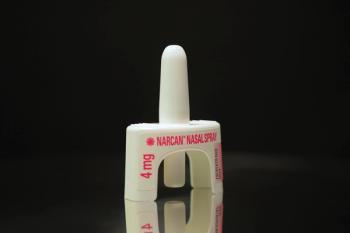
Insulin delivery: A disposable device eliminates need for several daily injections
The V-Go delivers CSII by means of a disposable patch device and provide insulin for 24 hours.
As rates of type 2 diabetes increase each year, novel approaches to management are necessary. Type 2 diabetes is a progressive disease requiring a variety of treatment regimens specific for each patient. Often patients require treatment intensification beyond oral diabetic medications, with subcutaneous basal insulin and eventually prandial insulin to obtain HbA1C goals.
One treatment shown to be effective for patients with type 2 diabetes who require insulin is continuous subcutaneous insulin infusion (CSII).1 In 2012 Valeritas brought to market its V-Go, a disposable insulin delivery device (DIDD) affixed by an adhesive patch.5 The V-Go is approved for adults with type 2 diabetes and may turn out to be a valuable treatment option for those requiring mealtime insulin.6
How it works
Through CSII, the V-Go maintains control of basal and bolus mealtime insulin coverage without the hassle of multiple daily injections (MDI). It delivers insulin through a 30-gauge, 4.6-mm floating hypodermic needle. It is mechanical, not electronic, and does not require batteries or software.2,3
The device is lightweight and compact, measuring 2.4 x 1.3 x 0.5 inches and weighing 0.7 to 1.8 ounces.2 It provides CSII for 24 hours as well as bolus doses of rapid-acting insulin on demand.
Both insulin aspart and insulin lispro have been tested in the V-Go. The bolus doses can be administered with two separate clicks. Clicking the bolus-ready button enables the activation of the bolus-delivery button. Pressing the bolus-delivery button releases two units of subcutaneous insulin, which should be administered 0-15 minutes before a meal.
The V-Go is available in three preset basal rates (20, 30, and 40 units daily). The bolus dosing is provided in two unit increments, with a total daily maximum of 36 units.2
Proof of concept
The proof-of-concept study to evaluate blood glucose control with a DIDD in type 2 diabetic patients was conducted over seven days. The device enabled patients to maintain blood glucose control, with a mean reduction in basal insulin of 19 units per day. Continuous glucose monitoring changes from 173 mg/dL to 157 mg/dL (P=0.063) demonstrated overall glycemic improvement.
Although the study sample size (N=6) was too small to prove safety and efficacy, the device was well tolerated, with 100% compliance.3
A retrospective analysis of glycemic control studying a cohort of 23 patients over 12 weeks found a statistically significant reduction in mean HbA1c by 1.2% (P=0.005), achieved through use of DIDD. Twelve weeks after discontinuation, the HbA1c increased to 8.2% (P=0.011).4
Patient adherence
Patient adherence is an ongoing challenge in management of diabetes. Benefits of DIDD use include the abililty to combine control of basal insulin with bolus insulin for mealtime coverage in a once-daily injection. The mealtime insulin is readily available; it is delivered when the appropriate buttons are pressed through the patient’s clothing.5,6
The V-Go is replaced every 24 hours. It can be prefilled with insulin lispro up to 24 hours before use and as long as five days before use with insulin aspart if refrigerated. (At room temperature it can be filled three days before use). It is billed through patients’ prescription drug coverage at the pharmacy.6
Limitations
The preset basal rates limit the V-Go as an option for patients with Type 1 diabetes, since their insulin sensitivity requires individualized incremental amounts of insulin. Its use also is limited in patients with Type 2 diabetes who are highly insulin-resistant and who require more insulin than the V-Go can deliver. There are prescription benefits that do not cover the V-Go, despite prior authorizations and appeals. It is possible for patients to have injection site reactions or irritation/sticky residue from the adhesive tape. Valeritas recommends a tape barrier and an adhesive remover wipe for these issues.6
CSII delivered by means of a disposable patch device allows the convenience of a once-daily injection to provide insulin for 24 hours, as well as before meals. This is novel technology that may increase compliance and reduce HbA1C. While it has its limitations, it offers an innovative option for adult patients with Type 2 Diabetes requiring basal and bolus insulin.
References
1. Wainstein J, Metzger M, Boaz M, et al. Insulin pump therapy vs. multiple daily injections in obese type 2 diabetic patients. Diabet Med. 2005;22:1037–1046.
2. V-Go Instructions for Patient Use. Valeritas, Inc., 2011.
3. Kapitza C, Fein S, Heinemann L, et al. Basal-prandial insulin delivery in type 2 diabetes mellitus via the V-Go: A novel continuous subcutaneous infusion device. J Diabetes Sci Technol. 2008;2(1):40–46.
4. Rosenfeld C, Bohannon N, Bode B, et al. The V-Go insulin delivery device used in clinical practice: Patient perception and retrospective analysis of glycemic control. Endocr Pract. 2012;18(5):660–667.
5. Sink J, Munz P. Patient adherence and insulin therapy in type 2 diabetes. Clinl Rev. 2013;S6–S9.
6. Skladany M, Miller M, Guthermann, LC. Patch-pump technology to manage type 2 diabetes mellitus: Hurdle to market acceptance. J Diabetes Sci Technol. 2008;2(6):1147-1150.
7. V-Go. [Internet]. Valeritas, Inc. 2014 [accessed Aug 12, 2014].
Lindsay Sheehan, PharmD, CDE, CPP, is Ambulatory Care Clinic Leader and Ambulatory Care PGY1 Residency Program Coordinator, Chronic Care Medication Management, Pharmacy Services-Carolinas Medical Center-NorthEast, Carolinas HealthCare System. Contact her at
Newsletter
Pharmacy practice is always changing. Stay ahead of the curve with the Drug Topics newsletter and get the latest drug information, industry trends, and patient care tips.





















































































































































